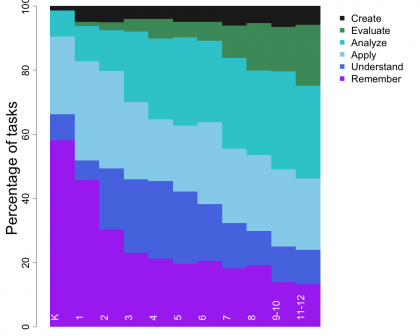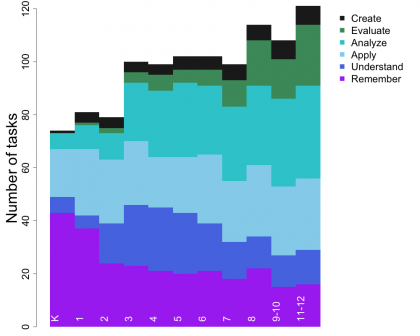
Bloom’s Taxonomy in the Common Core ELA Standards
Posted by cemignano on
In this 3-part series, BrainPOP’s Assessment Specialist, Kevin Miklasz, shares his analysis of the Common Core and Next Generation Science Standards in relation to the levels of Bloom’s taxonomy.
In the last blog post, I was inspired by Dan Meyer’s technique and broke the Common Core in discrete tasks, grouped by Bloom’s taxonomy. In this part 2, I’m continuing the analysis and looking at the Common Core ELA. Part 3, including the NGSS, is up next!
Common Core ELA
So, what are the Common Core ELA standards? Once again the top figure shows the percentage of tasks in each level of Bloom’s taxonomy, whereas the lower graph shows pure numbers of standards.
The ELA standards have a very different story from the Math standards. The number of tasks does increase with higher grade levels, but not as sharply as the math standards do. On the other hand, there is a clear progression towards higher level skills at higher grades. Analyze tasks become important from grade 3 onwards, and Evaluate tasks become important from grade 7 onwards. Understanding is a an important task between grades 2-6, but then starts to disappear from 6 grade onwards in favor of more Analyze and Evaluate tasks. In general, in higher grades simple comprehension is not enough- one is expected to not only comprehend but to compare and place texts in larger contexts.
So why such a difference between Math and ELA? It might have to do with the different nature of the subjects. Math is a series of inter-related but discrete topics. Each grade introduces new topics, with new vocabulary and techniques that require scaffolding. ELA, on the other hand, is a relatively small set of skills (reading, writing, listening, speaking), all of which are practiced at all grade levels. What changes is how those skills are expected to be practiced.
Notes on Methodology
In case you are curious how I did this analysis, here some details.
Some grade-specific standards contained multiple parts, or multiple tasks that they required from students. I coded each “task” required from students, which usually was one per standard, but sometimes was multiple tasks per standard.
The standards themselves note that they are overlapping, in that the same content is emphasized and described in different ways in multiple standards. By my analysis, this would give those kinds of semi-repeated tasks more weight, as they would be counted multiple times for each of the various places they appeared. I decided this was ok- things that were more crucial tended to be more often repeated, and therefore should get more weight.
The ELA standards were often very repetitive across grades. Higher grades would often require the same task, but in a more rigorous way. Typically some kind of adjective or adverb would be added to the sentence to describe exactly how the rigor was suppose to be added. For my purposes, making the task more “rigorous” by adding an adjective or adverb qualifier did not change how I coded the task.
About Kevin: Kevin entered education as a trained scientist- he has a PhD in Biology from Stanford University. Both during and after his graduate studies, he has spent his time gaining a smattering of diverse experiences in education: designing science curriculum, teaching after-school science programs, designing science games, running a “cooking as science” blog, designing online learning platforms, running professional development for teachers and professional engineers, and analyzing educational assessment data. Kevin is currently the Assessment Specialist at BrainPOP where he is designing new, playful and meaningful assessments on BrainPOP’s website.
















